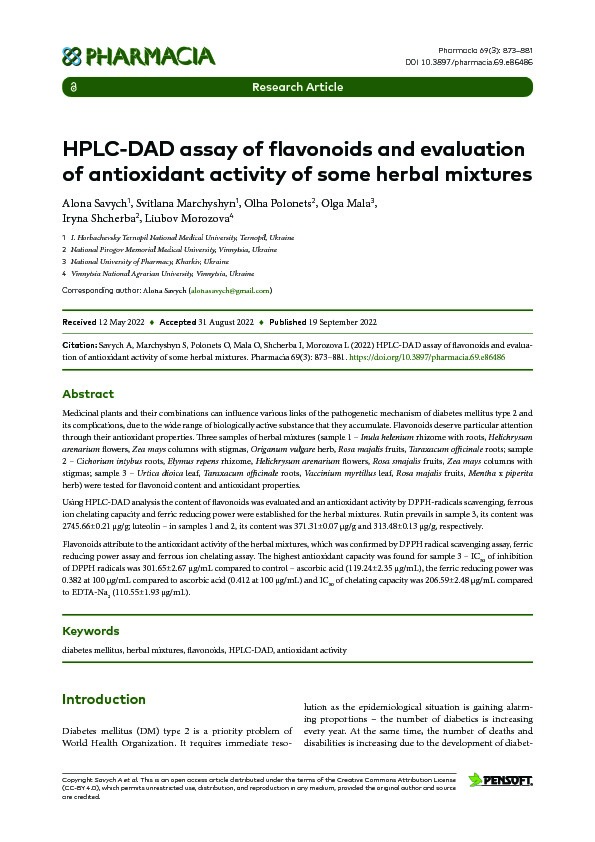id: 31594
Title: HPLC-DAD assay of flavonoids and evaluation of antioxidant activity of some herbal mixtures
Authors: Savych A., Marchyshyn S., Polonets O., Mala O., Shcherba I., Morozova L.
Keywords: diabetes mellitus, herbal mixtures, flavonoids, HPLC-DAD, antioxidant activity.
Date of publication: 2022-10-04 18:11:00
Last changes: 2022-10-04 18:11:00
Year of publication: 2022
Summary: Medicinal plants and their combinations can influence various links of the pathogenetic mechanism of diabetes mellitus type 2 and its complications, due to the wide range of biologically active substance that they accumulate. Flavonoids deserve particular attention through their antioxidant properties. Three samples of herbal mixtures (sample 1 – Inula helenium rhizome with roots, Helichrysum arenarium flowers, Zea mays columns with stigmas, Origanum vulgare herb, Rosa majalis fruits, Taraxacum officinale roots; sample 2 – Cichorium intybus roots, Elymus repens rhizome, Helichrysum arenarium flowers, Rosa smajalis fruits, Zea mays columns with stigmas; sample 3 – Urtica dioica leaf, Taraxacum officinale roots, Vaccinium myrtillus leaf, Rosa majalis fruits, Mentha x piperita herb) were tested for flavonoid content and antioxidant properties.Using HPLC-DAD analysis the content of flavonoids was evaluated and an antioxidant activity by DPPH-radicals scavenging, ferrous ion chelating capacity and ferric reducing power were established for the herbal mixtures. Rutin prevails in sample 3, its content was 2745.66±0.21 μg/g; luteolin – in samples 1 and 2, its content was 371.31±0.07 μg/g and 313.48±0.13 μg/g, respectively. Flavonoids attribute to the antioxidant activity of the herbal mixtures, which was confirmed by DPPH radical scavenging assay, ferric reducing power assay and ferrous ion chelating assay. The highest antioxidant capacity was found for sample 3 – IC50 of inhibition of DPPH radicals was 301.65±2.67 µg/mL compared to control – ascorbic acid (119.24±2.35 µg/mL), the ferric reducing power was 0.382 at 100 µg/mL compared to ascorbic acid (0.412 at 100 µg/mL) and IC50 of chelating capacity was 206.59±2.48 µg/mL compared to EDTA-Na2 (110.55±1.93 µg/mL).
URI: http://81.30.162.23/repository/getfile.php/31594.pdf
Publication type: Статті Scopus/Web of Science
Publication: Pharmacia. 2022. Vol. 69 (3). P. 873-881.
In the collections :
Published by: Адміністратор
File : 31594.pdf Size : 982523 byte Format : Adobe PDF Access : For all

| |
|
|